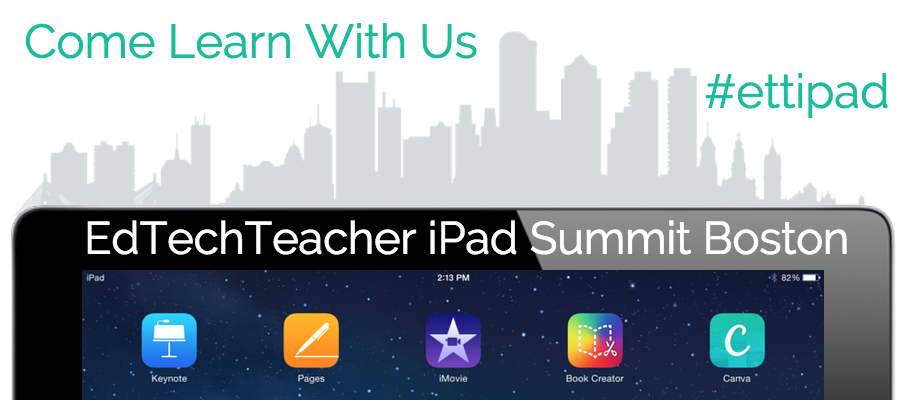Here at EdTechTeacher, we take pride in the fact that all of our Instructors and Presenters have been experienced classroom teachers as well as dynamic speakers. Not only do they have a wide array of knowledge in their field, but they also possess insights into the future of education. This summer and fall, we want to introduce you to our EdTechTeacher instructors and some of our EdTechTeacher iPad Summit Boston Featured Speakers in a new series called #ETTchat.

Kyle Pearce is a secondary school math teacher and Intermediate Level Math Coach with the Greater Essex County District School Board in Windsor, Ontario, is on a journey to improve student perception and understanding in mathematics. Recognized as an Apple Distinguished Educator, Apple Education Trainer, and Google Certified Teacher for his work in his classroom, he employs effective teaching strategies and uses technology to promote making math contextual and visual.
Q: What is your role in educational technology today?
A: For the past four years, I have had the unique opportunity to continue teaching a high school math class in the morning, while working as an instructional coach in the afternoon for grade 7 to 10 math teachers in my district. In my classroom, students learn math through a spiralled, task based approach and have access to a class set of iPads. With the support of my district, I am also able to share new ideas and learn from other innovators by attending world-class conferences like the EdTechTeacher iPad Summit in Boston.
Q: What was your professional journey to get you to where you are today?
A: I knew early on in my career that I wouldn’t be able to last 30 years teaching with traditional methods that included writing long notes on the chalkboard and giving a long list of examples each day. Within a few weeks of my first teaching assignment, I located a data projector and began creating digital resources to “engage” my students. Unfortunately, it took me a while to realize that substituting what I could have written on the chalkboard only impacted the behavioural engagement of my students; however, it did little to nothing intellectually. Luckily for me, I was surrounded by some great teachers who guided me early on and pushed me to try new things.
I now strive to teach following a 4-part math lesson approach that breaks away from the traditional format that I had been using for years and towards a task based approach. These aren’t your regular problems though; leveraging Dan Meyer-style 3 Act Math Tasks, these tasks promote inquiry beginning with context and visuals to move slowly from concrete to abstract math concepts. In the past, I did a lot of talking and the math work that went along with it. Now, students do the heavy lifting, but enjoy the process.
Q: What is the #1 piece of advice you have for teachers looking to bring iPads and other devices into their classrooms?
A: It is easy to decide that you want to use technology in the classroom. The hard part is determining why you are doing it. Although it is important for teachers to start somewhere in order to learn how to use technology, it is easy to believe that technology is the silver bullet. Technology is a tool that is unlikely to impact student learning outcomes unless you can come up with a reason for why you’re using it in the first place.
Q: What is your favorite tech tool or app today?
A: Right now, I’ve been collaborating with a tech startup called Knowledgehook. I am helping them bring a new gamified math assessment tool, that began as a Google Sheet through the work of Alice Keeler and Jon Orr, to a more user-friendly web app. It is my hope that within 6-months we will have a game changer for math assessment. In the meantime, they’ve also released a free gamified formative assessment tool called Gameshow that actually includes ready-made “Gameshows” for you to use in your math classroom, or you can create your own custom versions. Best of all, it is a web-based tool that can be accessed via any browser on any device.
A really interesting release from the folks at Desmos is the Activity Builder. Now, you can quickly go in and create a Desmos Math Learning Journey without all of the cumbersome linking. You can even ask questions and display the results of all students to make for a really interactive learning environment.
Finally, I’m also really excited about the new Explain Everything v3.0 that is out. With a ton of new features, those of you who are “Mathletes” will love that there is an equation editor and grapher. Now, creating an Explain Everything Math Learning Journey will be even easier than before!
Q: What comes to mind when you think of the classroom of the future?
A: The classroom of the future will be less about specific standards and more about creation. Finding ways to ignite passion in students to be creators instead of curators of knowledge is what we need to promote innovation instead of imitation.
Q: What are you up to for the rest of the summer or this fall before the Summit?
A: Having finished up a busy summer of conferences and full-day workshops, I’m now (relatively) free for a bit of R&R with my family before the school year begins in September. However, it won’t be long before October rolls around and I head to Norway to collaborate with the NORCAN project organized jointly by the teachers unions in Ontario, Alberta, and Norway.
In the meantime, stay in touch by following me on my blog, Tap Into Teen Minds and on Twitter.
To learn more from Kyle, join us at the iPad Summit in Boston when he presents "Making Math Contextual, Visual, and Interconnected with Technology." Check out his session description:
When you ask North Americans whether they understand math, the response more often than not is negative. Ask whether they find math enjoyable and that number is almost certain to decrease. This is a rather deflating fact for those of us entrusted to teach mathematics to students with very similar views at best. Although it might seem as though the deck is stacked against us, we now live in an age where technology makes it possible to teach math with context and visualization. Come experience how to leverage technology to engage and inspire students to not only enjoy mathematics, but understand the beauty of this universal language we share in our classrooms each and every day.


